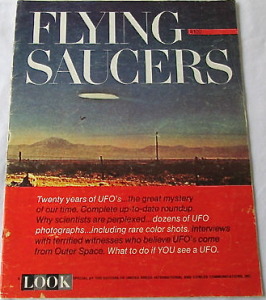In late 1956, Calvin C. Girvin began speaking about his series of flying saucer experiences. He'd recently been discharged from the Air Force where he'd served as a staff sergeant, and at the age of thirty, he was taking on a second career as a flying saucer lecturer. Girvin's tale was unique.
While the other Contactees were invited into saucers, Girvin woke from his bed at night to be commanded to come aboard a glowing spaceship. By his account, Girvin can be considered to be one of the first reported alien abductees.
 |
| Long Beach Press Telegram, Sept. 13, 1956 |
Girvin spoke at Giant Rock saucer convention in 1957 in advance of his book’s release, and thereafter had a busy lecturing career both solo at local venues and alongside major Contactee figures at national conferences.
 |
| Thy Kingdom Come - No 5. June, 1957 (PDF link) |
 |
| Santa Cruz Sentinel Feb. 22, 1959 |
According to Girvin's book, the alien re-animator possessed his body, making him a forerunner of the "walk-ins." After the war, Girvin was in contact aliens Cryxtan and Ashtar from Venus, who told him to join the Air Force so they he could spy for them to find out how much the US military knew about flying saucers - Gorvin did so, and even managed to get stationed in the Pentagon, but in food services, so his access to classified material was limited. The Venusians later commanded Girvin to write a book, and he did so, chronicling his spiritual and physical encounters. Girvin even painted the cover illustration, which depicted his encounter with the same type of flying saucer from Venus that George Adamski had described.
Girvin's book helped secure him more speaking engagements. There are many notices of his engagements, but below is one of the rare reviews of his lectures.
 |
| Pasadena Independent, Feb. 19, 1959 |
1959 seems to be the peak of Girvin's popularity. He was featured alongside two other famous flying saucer figures on a national television program, "People Are Funny.
 |
| Thy Kingdom Come - No 8. March-April 1959 (PDF link) |
Later the same year, he announced a second book, "In Search Of The Saucers," but it doesn't seem to have ever been published. However, he did paint the cover for Howard Menger’s book, From Outer Space to You.
Calvin Girvin was also on hand for the (aborted) launch of Otis T. Carr's flying saucer in Oklahoma City on April 17, 1959. Girvin was interviewed about his book and experiences for the Long John Nebel radio show on WOR. Link to recording:
Gabriel Green, of the Amalgamated Flying Saucer Clubs of America was the most frequent host for Girvin's lectures, and he continued speaking throughout the late 1950s and the 1960s. Perhaps even beyond 1969, but there's little documentation of Girvin's later years. There's evidence his interest in the paranormal remained strong, though. Ingo Swann was a superstar psychic, a key player in the CIA's Project Star Gate Remote Viewing program. The University of West Georgia hosts the Ingo Swann Papers, and it contains correspondence from Calvin Girvin on remote viewing and other topics beyond conventional science:
"5 Jun 1994 typed letter from Calvin Girvin to Ingo Swann discussing his personal experiences with the paranormal and his lifelong interest in many subjects. Enclosed with an article Girvin authored “Magnetic Bra Prevents Breast Cancer” along with several notes about the biomagnetic differences between the north and south poles and their uses in energy medicine. (eight leaves), 1994"
That's the last documented UFO-related contact we could find for Girvin, and the only other information we could find was the date of his death, May 14, 2005, given as the site, Kook Science. That's the end of the story, but we saved the perhaps most interesting part for last, Girvin's early contact with the the legendary wee folk of Hawaii.
Meeting the Metahunes
Months before Calvin C. Girvin became known on the mainland for his flying saucer contact, he was in the Hawaii news for having encounters with their pixie or troll-like Menehunes. Girvin already had some rich experiences under his belt, some psychic in nature, and he had plans to write a book.
Calvin Girvin's story is full of incredible experiences, such as healing by aliens and channeling messages. Such things were not taken seriously then by ufology. Times change.
As with so many of the most interesting UFO cases featured here at The Saucers That Time Forgot, Project Blue Book has no files on Girvin's encounters.
As with so many of the most interesting UFO cases featured here at The Saucers That Time Forgot, Project Blue Book has no files on Girvin's encounters.
Click this link for additional newspaper stories on Calvin C. Girvin.
. . .
Title Trivia
For the title of his book, Girvin borrowed a line from the 1873 poem "Light" by Francis William Bourdillon:
The Night has a thousand eyes,And the Day but one;Yet the light of the bright world diesWith the dying sun.The mind has a thousand eyes,And the heart but one;Yet the light of a whole life diesWhen love is done.

































